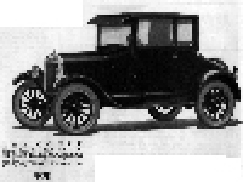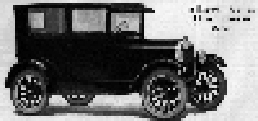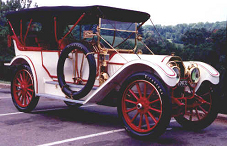Some background on cars seems to be appropriate here. The first
mass produced car was made by Henry Ford and was called a Model T and was
manufactured from 1909 to 1927. To start the Model T it was cranked
by hand. Underneath the radiator was a hole in which the crank was
placed leading to the motor. As you turned the crank the motor would be
turned over. You had to be careful as when the car started the crank
had a tendency to jump backwards. If you held on to the crank it
could jerk your arm into part of the frame that held the radiator and break
your arm. There were two gears on the column holding the steering
wheel. One of those adjusted the spark and the other was the magneto.
They had to be adjusted just right for the car to start. You could
have any color Model T you wanted, if that color was black. It had
no battery.

1926
Ford Model T Coupe
|

1926
Ford Model T Touring Car
|
The first cars were called horseless carriages. Basically they were
buggies to which a motor had been added to replace the horse. Wagons
and buggies had wheels which were made of wooden spokes with an outer rim
of steel to hold things together. These first cars also had wheels
with wooden spokes and an outer rim of steel. To this outer rim was
added a solid piece of rubber around the steel rim. It was not until
later that tires with inner tubes filled with compressed air came into
being.
The introduction of cars had a profound effect on the economy.
The number of people employed as buggy whip makers, reins and harness makers,
farriers and livery stable workers diminished drastically. New demands
for oil field workers, refinery workers, gasoline dealers, tire repairmen
and mechanics increased. Gulf Oil opened the first gasoline station
in 1913.
Ford came out with an improved car. It was also painted only black
and was called a Model A. It also had to be cranked to start it.
That was followed by a Model B also only black which had a self starter.
Others started to manufacture cars. William Durant was a buggy
manufacturer in Michigan. In 1909 he asked Louis Chevrolet to help
design a car. The first Chevrolet was made in 1911.
Barney Oldfield also helped design a car. The first Oldsmobile
was made in 1911.

1911
Oldsmobile
A company called General Motors was formed. In 1918 Chrevolet
became part of General Motors. In that year the first Chevrolet truck
was manufactured.
Other makes of early cars were the Whippet, Hupmobile, Nash, Cord, Willys,
Studebaker, Stutz, Pierce Arrow, Oakland, Packard, Reo, and Duesenberg.
Of course none of these early cars had heaters, air conditioners, or
radios. The first car with a radio was the 1924 Chevrolet.
Windows were not made of glass but rather a substance called isenglass.
The first cars had no lights and thus were not made to be driven at night.
Some owners put kerosene lanterns on their cars and drove them at night.
Some cars a little later had carbide lights. These were little
tanks holding water and a box on top of the water holding carbide.
A valve would be opened to allow the carbide to enter the water thus forming
acetylene gas which could be lit with a match.
There were two basic types of these early cars. Those with a front
and back seat were called Touring cars. Those with a single seat
were called Coupes. Some coupes had a door where today would be a
car trunk. That door opened down and in that space was another seat
called a rumple seat.
The earliest cars had horns so the driver could warn people to get out
of the way. These first horns were nothing more than a rubber bulp
attached to a reed. When the rubber bulb was squeezed the air in
it would activate the reed so it vibrated and produced a sound. Later
there were electric horns. The sound produced was oooogha or uuuughu
or uuuugha. It was not until about 1931 that horns such as we hear
today were on cars.
The early cars could be repaired much easier than those of today.
If you raised the hood you could reach any part that needed repair in the
engine department. A few wrenches, pliers and a screwdriver was all
you needed. The term “shade tree mechanic” was created. Repairs
were literally made under a shade tree. It was said that with a pair
of pliers and some baling wire you could keep a Model T or Model A or Model
B running. That was an exageration but not by much.
The first car I remember my father owned was a 1933 Chevrolet.
I know he owned cars before that. In fact I have the papers where
he registered a 1916 Oakland. Men have always talked about their
cars with other men. One of the sisters of my mother was named Leota.
Leota married Frank Shaw. Uncle Frank was a great believer in Ford
automobiles. At one time he owned a 1937 Ford. At that time
my Dad owned a 1936 Chevrolet. I remember the two of them discussing
and the attributes of each with my father listing the drawbacks of Fords
and Uncle Frank those of Chevrolets.
Before World War II all cars had manual transmissions. There was
a gear shift on the floor to the right of the driver. You had to
manually shift through the gears. There were usually three forward
and one reverse gear all activated by this gear shift. Today many
drivers have never driven anything except cars with automatic transmissions.
One of the earliest automatic transmissions was called a Hydromatic.
I think that first appeared in Buicks. Dodge came out with something
called Power Glide.
The Willys Motor Company designed probably the best known motor vehicle
ever and that was the Jeep for the use of the military. Others also
made Jeeps using the Willys plans and specifications.
During World War II no cars were made for civilians. Those that
owned cars when the War started kept repairing them as best they could
but many wanted new cars but could not buy them. In addition many
became of age during the War and wanted cars. More wanted cars than
American companies could build. Adolph Hitler had decreed there ought
to be a car everyone could afford. The Germans complied with a car
called the Volkswagen. Volkwagen translates from German to English
as “People’s Car.” A more expensive, sportier car made by Volkswagen
was the Karman Ghia. The first Volkswagen was developed by Ferdinand
Porsche in the 1930s. He lost interest until the decree by Hitler.
The first ones were made in 1938 but production was halted due to the beginning
of World War II when Hitler geared up to invade Poland in 1939 starting
the War.
When the War ended the Volkwagen was redesigned and a model came out
which was swiftly identified as the Beetle. It was cheap and sold
rapidly throughout the world. About this time the Japanese came out
with cheap cars. These first ones were not of high quality.
The Japanese Toyota and other makes coupled with the Volkswagen satisfied
much of the demand for cars in the United States. After World War
II other makes of automobiles were the Nash and the Hudson as well as the
Henry J.
After World War II people did all sorts of things to make their cars
unique. I will mention some of those. Horns were available
that played 8 to 16 bars of a tune. Many purchased a knob to place
on the steering wheel. Instead of grasping the steering wheel on
its edges you grasped the knob and turned the steering wheel with that.
Others purchased covers to place over the seats – seatcovers. These
were available in all sorts of patterns. One in particular resembled
leopard skin. Some would remove the muffler, remove the insides and
replace it. This resulted in a vroom or warbling sound, the louder
the better. This was before there were catalytic converters.
Fender skirts were another. These fit so that the area under the
fender and to the hub cap of the wheel was ½ covered.
The first motor vehicle I owned was a Cushman motor scooter. I
bought it used in 1949 and sold it to my cousin Vic in 1950 when I
bought a 1936 Chevrolet four door sedan. I sold that when I was transferred
from Lackland Air Force Base in San Antonio to Sampson Air Force Base near
Geneva, New York.
My next car was bought in early 1951 and was a 1947 Plymouth coupe.
I wrecked that car in late 1951. In 1952 I bought a 1949 maroon
Ford convertible. I still owned that car when I got married and drove
it until 1954 when I bought a 1954 Pontiac. That car was traded in
on a 1959 Plymouth Fury. The gears were shifted by pushing buttons
on the dash. That car had huge tail fins. From that 1959 Plymouth
until 1988 I owned only Chrysler Corporation made cars.
After I moved to Niagara Falls in 1968 all my cars were purchased at
Joe Cecconi Motor Company in Niagara Falls. I first owned Dodges
and then Chryslers. I owned a succession of Fifth Avenues.
When my oldest son, Donald Patrick II, graduated from college
I gave him the Dodge I was then driving and bought a Chrysler Fifth Avenue.
That was a Dodge Polara. He drove it for several years and finally
sold it to his brother-in-law who drove it for several more years.
I think it had over 200,000 miles on it when the brother-in-law finally
got rid of it.
When my daughter, Denise Marie, graduated from college I bought
her a new Plymouth. I think the model was caused Horizon. When
my youngest son, David Michael, graduated from college I also gave
him a new Dodge which I think was a Neon.
When I moved to Fort Worth in 1987 I was still driving a Chrysler Fifth
Avenue. I had taken my Chrysler to a particular dealer in Fort Worth
several times for service. Once I took my step-sons Plymouth to that
dealer for an oil change. While I was there I asked the Service Manager
to check his records to see when my Chrysler was due for service.
He asked me what the Vehicle Identification Number (VIN) was for my Chrysler.
I told him I did not know. He said all the records were kept by VIN
number and not by customer name. I decided I would no longer patronize
a place that had such an impersonal attitude. That was in 1988.
Shortly after that I decided to buy a new car. Because of the Chrysler
dealer’s attitude I shopped for other makes. I bought a 1988 Cadillac
Sedan DeVille. I kept that car until 1995 when I bought a 1995 Buick
Roadmaster that I still drive.
I wonder if anyone has noticed how the 2001 Chrysler PT Cruiser looks
so much like a 1937 Ford? |